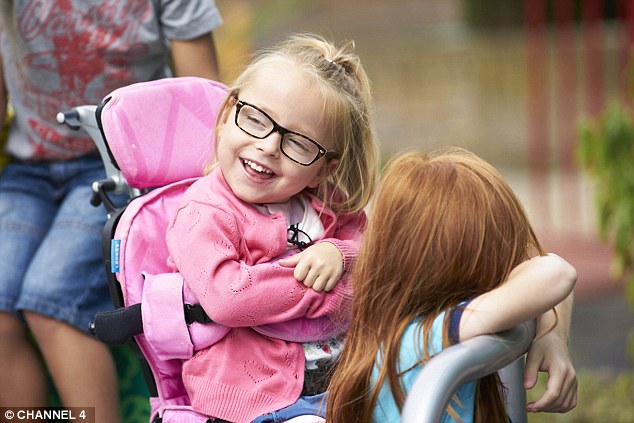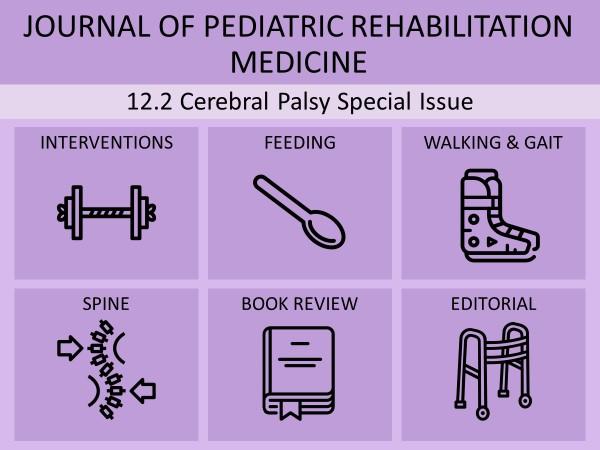New insights: Improving function, independence and quality of life of individuals with cerebral palsy
Experts from across the world share new research and highlight developments in caring for individuals with cerebral palsy in the Journal of Pediatric Rehabilitation Medicine.

‘I am happy as I am’: Little Daisy becomes the first child in a wheelchair to be featured on the Secret Life of Five Year Olds – as her mother insists her disability won’t hold her back. Daisy Mason, 5, from Norfolk, has spastic quadriplegic cerebral palsy. Daily Mail Online
Diana Murray, EurekAlert! August 22, 2019
Amsterdam, NL – Cerebral palsy (CP) is one of the most common movement disorders in children. A growing number of caregivers worldwide are caring for children, adolescents and adults with child-onset CP. In this collection of articles in the Journal of Pediatric Rehabilitation Medicine, experts from different disciplines share their experience and summarize new research directed at maintaining and improving function, independence and quality of life in individuals with CP.
This special issue, guest-edited Deborah Gaebler-Spira MD, Professor of Physical Medicine and Rehabilitation and Pediatrics, Feinberg School of Medicine, Northwestern University, Chicago IL, and Michael M. Green DO, Associate Professor of Physical Medicine and Rehabilitation, School of Medicine, University of Utah, Salt Lake City UT, highlights the issues faced by individuals with CP and their carers and brings together new knowledge for the care of children and adults.

This special issue reflects the important role that pediatric rehabilitation medicine (PRM) plays in managing children and adults with CP, including providing early diagnoses, realistic goal setting, and complex comprehensive patient management throughout childhood and into adulthood. PRM is a value-adding partner in the clinical lives of people with CP. Feinberg School of Medicine, Northwestern University, Chicago
CP occurs in about 1.5 to more than 4 per 1,000 live births and continues into adulthood, requiring ongoing rehabilitation. Symptoms include poor coordination, stiff muscles, weak muscles, and there may be problems with vision, hearing, swallowing, speaking, bowel and bladder, and sensation. Children are also at risk of malnutrition due to feeding problems that are common in CP. There is no cure, but supportive treatments, medications and surgery may help. Children with CP may live a full life, depending on the severity.
This collection of articles taps into the expertise of an international group of scientists and discusses multiple aspects of caring for children and adults with CP. The editors hope to promote multidisciplinary thinking and collaboration to improve outcomes.
The articles in this issue cover topics such as:
- How to improve scoliosis care
- Realistic goal setting
- Home exercise programs to improve walking ability in children with diplegia
- How to improve walking speed in adults with CP
- Prevalence and goal attainment with spinal orthoses for children
- Efficacy of prefabricated carbon-composite ankle foot orthoses
- Improving postural symmetry in children with hemiplegia
- Safety of intramuscular injections in children with CP
- Nutritional care
- Classification system for assessing eating and drinking ability
“Children with CP and their families have always been a significant part of the scope of the Journal,” explained Dr. Green. “They are frequently seen in trans-multi-interdisciplinary settings with pediatric rehabilitation medicine playing a significant role in their care, for example, spasticity management. The practice of spasticity management continues into adulthood as do other functional interventions.”
“We in pediatric rehabilitation medicine have a unique understanding and are in an important position to bridge the lifespan gap that exists in other medical communities,” added Dr. Gaebler-Spira. “Our training exposes all of us to adults with disability. Faculty enthusiastically engage with all pediatric rehabilitation medicine residents by teaching and expanding the clinical care for children with CP who are aging into adulthood. Many of us in academic programs have taught the next generation of pediatric rehabilitation providers to consider the needs of adults with CP and continue to work with adults to maintain function and independence.”
Recognizing that there is no cure for CP, childhood disability is now an applied science that focuses on function, family, fun, future, fitness and friends. The goal is to increase functionality, improve capabilities and sustain health with respect to locomotion, cognitive development, social interaction and independence. Symptomatic treatment programs involve physical and behavioral therapy, pharmacologic and surgical treatments, mechanical aids and management of associated medical conditions.
The creation of sub-specialties such as pediatric rehabilitation medicine and neuromuscular medicine now provide specific pathways for training. There is also a clear need among healthcare providers for explicit and clear agreements on how to measure and provide nutritional care for children with CP.
“The ultimate treatment goal is to improve activity, participation and quality of life,” concluded the editors. “The challenge ahead is to get all of us working together to improve the lives of the individuals we serve.”
Source EurekAlert! AAAS
| References |
Cerebral Palsy, Michael M. Green and Deborah Gaebler-Spira. J Pediatr Rehabil Med. vol. 12, no. 2, pp. 115-121, 2019. DOI: 10.3233/PRM-190008. PDF
It all started with a clubfoot: Beliefs surrounding cerebral palsy throughout history, Stang, Kristina M. King, Nicholas E. Gaebler-Spira, Deborah. J Pediatr Rehabil Med. vol. 12, no. 2, pp. 115-121, 2019. DOI: 10.3233/PRM-190005. PDF
The Eating and Drinking Ability Classification System for cerebral palsy: A study of reliability and stability over time, Sellers, Diane. Bryant, Elizabeth. Hunter, Alison. Campbell, Vivienne. Morris, Christopher. J Pediatr Rehabil Med., vol. 12, no. 2, pp. 123-131, 2019. DOI: 10.3233/PRM-180581
Nutritional care: The ‘poor child’ of clinical care in children with cerebral palsy, Snik, D.A.C. Jongerius, P.H. Roos, N.M. de. Verschuren, O. J Pediatr Rehabil Med. vol. 12, no. 2, pp. 133-138, 2019. DOI: 10.3233/PRM-180537
Improving postural symmetry: The effectiveness of the CATCH (Combined Approach to Treatment for Children with Hemiplegia) protocol, Holland, Holly. Blazek, Kerry. Haynes, Margo Prim. Dallman, Aaron. J Pediatr Rehabil Med. vol. 12, no. 2, pp. 139-149, 2019. DOI: 10.3233/PRM-180550
Passive range of motion changes in young children with spastic diplegia. A study during the initial stages of independent walking, Dimakopoulos, Rigas. Syrogiannopoulos, George. Youroukos, Sotirios. Dailiana, Zoe. Spinou, Arietta. J Pediatr Rehabil Med. vol. 12, no. 2, pp. 151-159, 2019. DOI: 10.3233/PRM-180539
Structured home-based exercise program for improving walking ability in ambulant children with cerebral palsy, Fauzi, Aishah Ahmad. Khayat, Masyitah Mohammad. Sabirin, Sakinah. Haron, Norazah. Mohamed, Mohd Nahar Azmi. Davis, Glen M. J Pediatr Rehabil Med. vol. 12, no. 2, pp. 161-169, 2019. DOI: 10.3233/PRM-180538
Efficacy of prefabricated carbon-composite ankle foot orthoses for children with unilateral spastic cerebral palsy exhibiting a drop foot pattern, Altschuck, Natalie. Bauer, Christian. Nehring, Ina. Böhm, Harald. Jakobeit, Martin. Schröder, A. Sebastian. Mall, Volker. Jung, Nikolai H. J Pediatr Rehabil Med., vol. 12, no. 2, pp. 171-180, 2019. DOI: 10.3233/PRM-170524
Self-reported physical function is associated with walking speed in adults with cerebral palsy, Baer, Heather R. Thomas, Sruthi P. Pan, Zhaoxing. Tagawa, Alex. Carollo, James J. Heyn, Patricia C. J Pediatr Rehabil Med. vol. 12, no. 2, pp. 181-188, 2019. DOI: 10.3233/PRM-180585
Safety of combined salivary gland and multilevel intramuscular onabotulinumtoxinA injections with and without ethanol in pediatric patients with cerebral palsy: A retrospective study, Shoval, Hannah. Levin, Jared. Friel, Kathleen. Kim, Heakyung. J Pediatr Rehabil Med. vol. 12, no. 2, pp. 189-196, 2019. DOI: 10.3233/PRM-180552
Prevalence and goal attainment with spinal orthoses for children with cerebral palsy, Pettersson, Katina. Rodby-Bousquet, Elisabet. J Pediatr Rehabil Med. vol. 12, no. 2, pp. 197-203, 2019. DOI: 10.3233/PRM-180596
Perioperative management of patients with cerebral palsy undergoing scoliosis surgery: Survey of surgeon practices, Belthur, Mohan. Bosch, Liam. Wood, William. Boan, Carla. Miller, Freeman. Shrader, M. Wade. J Pediatr Rehabil Med. vol. 12, no. 2, pp. 205-212, 2019
